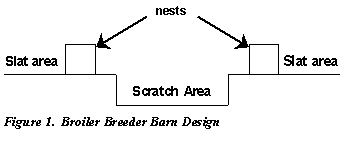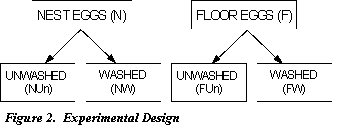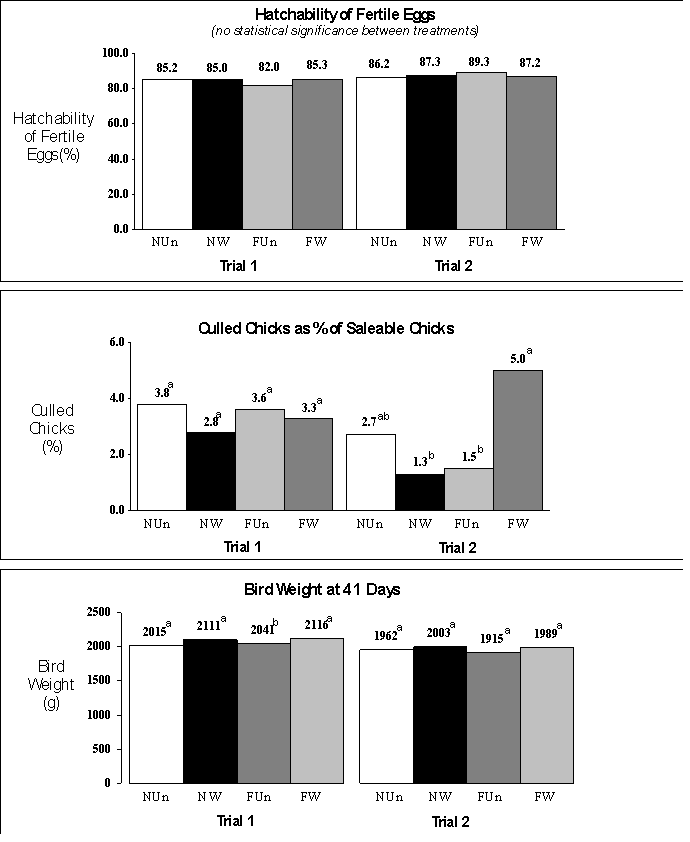| | Why did we do this experiment?
Different sectors of the broiler industry are linked very closely. What happens in one sector of the poultry industry will affect the other sectors. With the increased push towards establishing on-farm HAACP programs, it is necessary to examine how management decisions in one sector of the broiler industry will affect the product further down the broiler chain. The ultimate goal is to improve the efficiency of the poultry industry for all sectors and to provide scientific based information that will help to maintain and improve product quality of poultry products produced in Alberta.
What is the design of a broiler breeder barn?
Most broiler breeder barns are designed so part of the barn floor area is made up of a "scratch" area covered with litter, with the remaining area made up by elevated "slats". (see figure 1) The slats are about 12-18" higher than the scratch area. The nests are located on top of the slats. In an ideal situation, all the hens would lay their eggs in the nests, where the eggs would be collected by a mechanical belt. Unfortunately, not all eggs are laid in the nests. Some hens get in the habit of laying eggs on the slats or on the scratch area. Barn and nest design may be a factor in "encouraging" hens to lay in these areas. Strain of bird may also play a role, but sometimes the reasons for birds not laying in the nests are unclear.

Why are floor and slat eggs not desirable?
It is much more labor intensive for the broiler breeder producer to collect eggs from the floor and the slat areas than from the mechanical egg collection system. In addition, floor and slat eggs are not as desirable as these areas are not as clean as the nest boxes. Eggs laid in these areas are more likely to be in contact with manure and dirty litter; this can increase the opportunity for bacteria to enter the inside of the egg. The eggshell is not a solid structure. There are tiny holes all over the eggshell that allow oxygen to enter the egg and carbon dioxide to leave the egg during incubation and growth of the broiler embryo.
Why are hatching eggs washed and how are they washed?
Hatching eggs are washed to remove small areas of manure that have come in contact with the surface of the eggshell. Hatching eggs are usually washed in water with a wash a washing compound that acts as a disinfectant. It is important to maintain a wash water temperature that is hotter than the eggs themselves (usually about 43-45oC). If the temperature of the water is cooler than the inside of the egg, the wash water will actually be drawn inside the egg. Frequent changing of the wash water also helps to maintain the disinfecting ability of compounds containing chlorine; organic material such as manure will inactivate the disinfecting ability of chlorine.
How was the experiment conducted?
We went to a local broiler breeder producer, and collected equal numbers of eggs from both the nests and from the floor. (See figure 2 for experimental design) After the eggs were collected we again divided each group into equal numbers of eggs. Half the eggs collected from the nests were washed (according to the way the broiler breeder producer washed the eggs) and the other half were left unwashed. The same treatment was given to the eggs collected from the floor. All the eggs were transported back to the Alberta Hatching Egg Producers Hatchery and the eggs were set in separate incubators to incubate. After the chicks hatched out, the chicks were feather sexed and hatchability calculated. The male and female chicks from each of the treatments were placed in separate pens at the Alberta Poultry Research Centre and grown out until 42 days of age. All mortality was recorded and the bird weight gain, feed consumption, and feed conversion was calculated for each of the treatments. This experiment was completed with a flock that was 36 (Trial 1) and 44 (Trial 2) weeks of age.

Hatchability Results.
In both Trial 1 and 2 there was no statistical difference between any of the treatment groups for hatchability of fertile eggs. This means that neither the area where the egg was laid nor the washing of the eggs had an affect on the ability of the eggs to hatch. Also the number of rotten eggs was not different between the treatments (data not shown).
Chick quality results
The results of the first trial showed that there was no statistical difference between any of the treatment groups with respect to chick quality. However, the results from trial 2 showed that the floor washed eggs had poorer chick quality when compared to the floor unwashed or nest washed treatments. Chick quality was not statistically different between the nest unwashed, nest washed, or floor unwashed treatment groups.
Broiler Growth Results (Males & Females Combined)
Egg source significantly affected bird weight at 41 d; in both trials the bird weight was lower in birds from floor versus nest eggs (data not shown). In both trials, birds from washed eggs had higher 41 d weights compared to birds from eggs not washed (data not shown). In the first trial the results showed that the floor unwashed group had a lower body weight at market age compared to the other treatment groups. There was no statistical difference between any of the treatment groups with respect to market body weight in trial 2. Total mortality and total feed conversion was not different between the treatments nor the interaction of the treatments for either of the trials.
Summary.
Although hatchability was not influenced by the treatment groups in the two trials, it should be noted that the shell quality from the flocks used in this experiment was good. Also the egg washing procedures were very strictly controlled. Even though hatchability was not affected by the area in which the egg was laid or the washing treatments, final broiler body weights were influenced. Birds from floor eggs and from eggs that were unwashed had lower market weights. This could have been a result of an underlying bacterial infection in the birds which was not severe enough to cause an increase in mortality, but was bad enough such that the birds had to divert energy away from growth to fight the infection.

Gaylene Fasenko, Frank Robinson, Melissa MacLean*, Mike Hittinger*, and Beth White* (Authors noted by * were members of the Animal Science 471 class in 2000)
Poultry Research Centre News Vol 10 No 3, November 2001 |
|